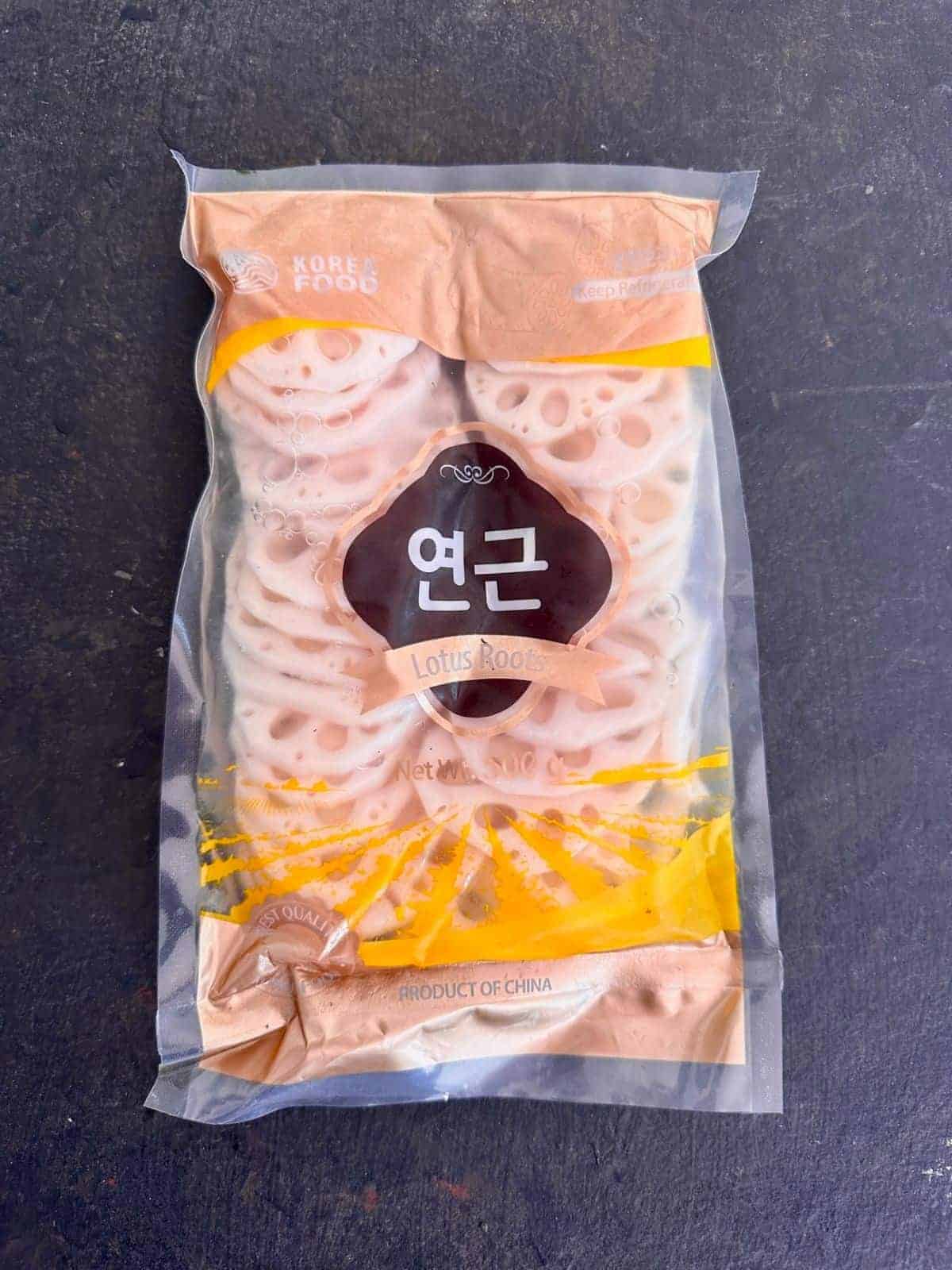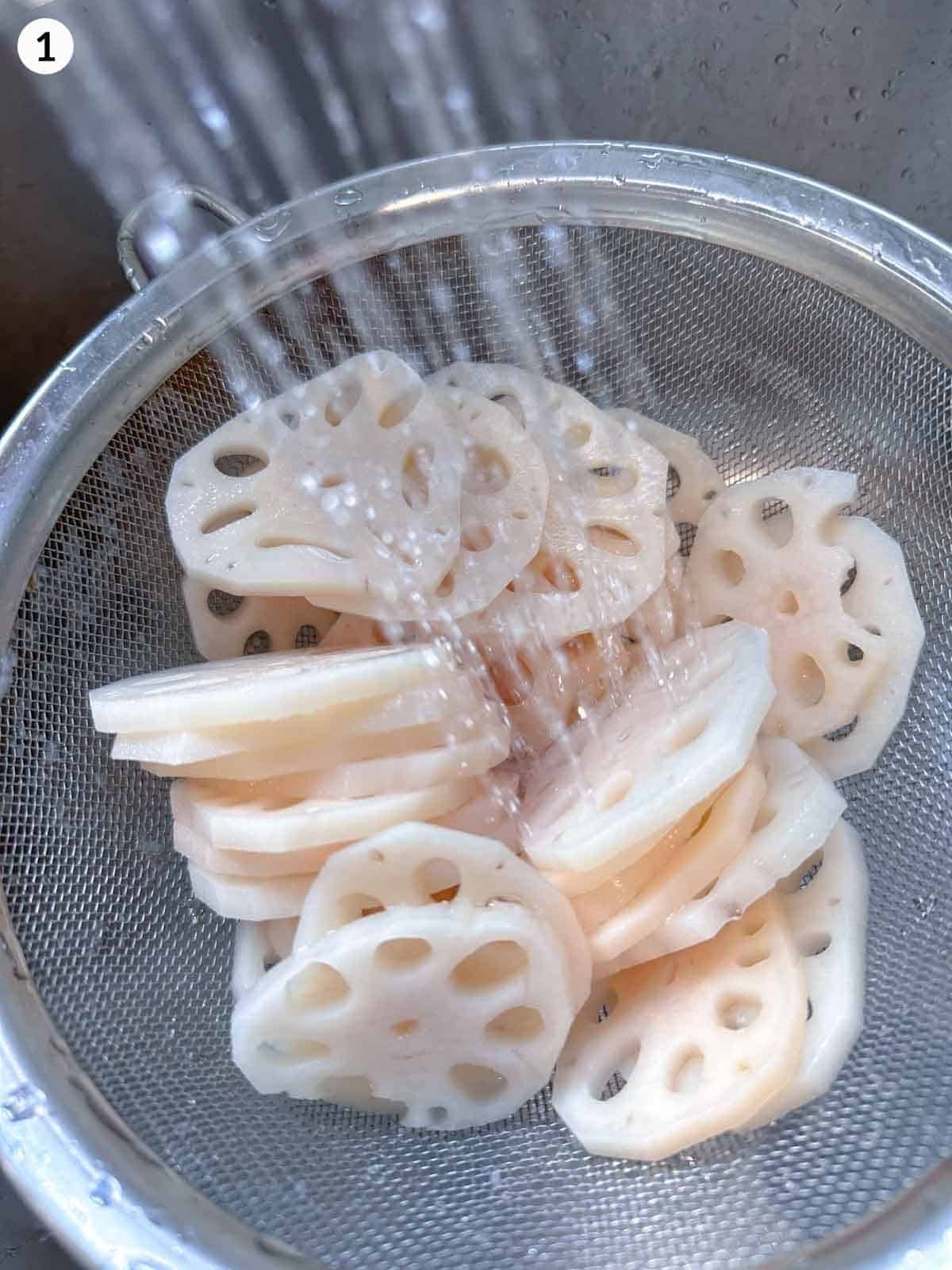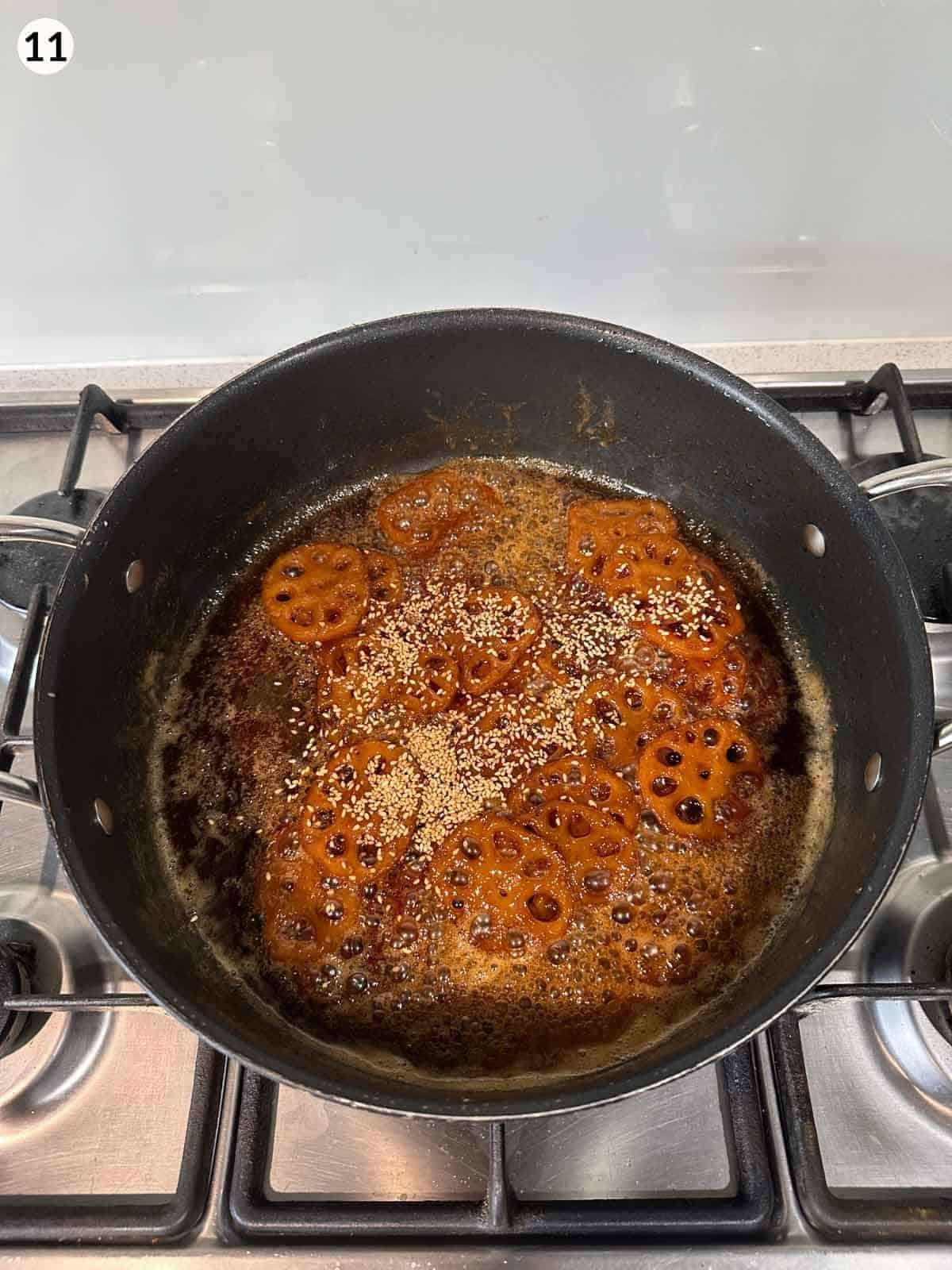This Korean lotus root recipe is easy to make at home with only a few ingredients and will tantalise your tastebuds! Sweet and sticky with a slight crunch, it is incredibly moreish!
Jump to:
Why You’ll Love Korean Braised Lotus Roots
Korean braised lotus roots are a culinary marvel, boasting a delightful blend of textures and flavours that make them irresistible. The lotus root, with its porous, crunchy texture, absorbs the savoury, slightly sweet sauce, creating a harmonious balance.
Each bite offers a symphony of tastes, from the earthy undertones of the lotus root to the umami-rich soy sauce and the sticky sweetness of the slow braised sauce. Once you start, you simply can’t stop.
This yeongeun jorim recipe is one of those banchan that you always hope will make an appearance. Best of all, it only takes a few ingredients and you can make it in your very own kitchen.
What Does Lotus Root Taste Like?
Lotus root has such a unique appearance and taste. Its flavour is delicate, with a subtle sweetness that’s often compared to a cross between a potato and a water chestnut.
This gentle flavour profile makes lotus root incredibly versatile, as it can take on the taste of the ingredients it’s cooked with while still adding its own distinct texture and character to a dish.
One of the most remarkable qualities of lotus root is its texture. When raw, it is crisp, crunchy, and slightly fibrous, like a raw potato or jicama.
However, when cooked, lotus root undergoes a transformation, becoming tender and almost creamy, with a melt-in-your-mouth quality that is truly unique.
This texture adds a wonderful contrast to dishes and makes lotus root a favourite in many Asian cuisines, where it is prized for its ability to add both flavour and texture to a wide variety of dishes.
Make sure you also try our hot and sour stir-fried lotus root or lotus root salad with pickled shiitake mushrooms.

How To Buy Lotus Root?
Fresh lotus root is not always easy to come by in non-Asian countries, but it is certainly not impossible. Our local Asian supermarket in an Asian community stocks them regularly. They are, however, not always so affordable.
You may however be able to find sliced Korean lotus root in the freezer section. They may come in different thicknesses. Japanese renkon chips, or simply lotus root chips, have rendered it a popular enough ingredient for them to be available in really thin slices.
The Chinese love to stir fry lotus roots or add them to soups. So, they tend to be sliced thicker. This is a more appropriate thickness as they do shrink when cooked. The renkon chip thickness is too thin and may disintegrate over time.
You can also try to find lotus root slices in pre-packed versions that are in brine. Much easier than having to slice fresh lotus root or defrost frozen packets.
Recipe Overview
Flavour/Texture: Korean braised lotus root offers a delightful combination of flavours and textures. The lotus root itself retains a slightly crunchy texture even after being braised, providing a satisfying bite that contrasts beautifully with the tender, juicy interior.
The flavour is a harmonious blend of savoury and sweet, thanks to the soy sauce and rice syrup used in the braising liquid.
The lotus root acts as a sponge for the rich sauce, absorbing all the delicious flavours and becoming infused with the essence of the dish.
This results in a dish that is not only visually appealing, with its intricate patterns and glossy sheen, but also bursting with complex flavours that make each bite a delight.
Ease: This is an easy-to-make at-home Korean banchan that only requires a few ingredients.
Time: This Korean lotus root recipe does require time. The braising of the lotus roots is ultimately what makes it all soft and sticky, so do persist with the timing. You’ll be fairly rewarded afterwards!
Ingredients
These are the ingredients you need for Korean braised lotus roots:

Lotus root: Fresh, frozen or in brine, it will all be suitable for this recipe.
Rice wine vinegar: Just a couple of tablespoons will suffice for the blanching process before you start braising the lotus root.
Soy sauce: An essential ingredient to allow for the salty and umami flavours as well in assisting in the darker appearance of the finished dish.
Rice syrup: Easily found in Korean supermarkets, although any rice syrup would work.
Sesame oil: Gives a really nice nutty flavour at the end as it is tossed through the braised lotus roots. Also gives it that nice glossy finish before serving.
Sesame seeds: A quintessential Korean ingredient.
Variations and Substitutions
Rice wine vinegar substitute: You can use apple cider vinegar if you don’t have any rice wine vinegar.
Rice syrup alternative: We like to use Korean rice syrup for all our Korean recipes, but you can use any rice syrup or even corn syrup. Its function is to create that sticky, sweet finish when braising the Korean lotus roots and both will work.
Instructions
Step by step instructions for how to make Korean braised lotus roots:
If using fresh lotus root, peel and slice thinly. If using pre-sliced packaged lotus root, remove from brine and wash thoroughly. If using frozen lotus root, defrost thoroughly, rinse and wash. Then soak in cold water for 30 minutes.
Bring a saucepan of water to the boil, add lotus root and rice wine vinegar and blanch for 5 minutes. Drain and rinse.


Add vegetable oil to a fry pan and add lotus root. Fry for 3 minutes or until it is slightly translucent and has begun to soften.

Add soy sauce, water and garlic. Stir gently.


Bring down to a simmer for about 45 minutes with cover on. Check occasionally to ensure water hasn’t completely evaporated. Add more if required.


Then add the rice syrup, stir, and cover again for a further 20 minutes.

Remove the cover. Bring heat up to medium and stir for another 10 minutes until the sauce is all absorbed and forms a sticky finish.




Once completed, turn the heat off, stir through sesame oil and sesame seeds and serve.
How to Make This Side Dish Perfectly [Expert Tips!]
Soaking and blanching lotus root: It is important to soak the lotus root and then blanch in vinegar water as it assists in removing any bitterness and also to avoid the lotus root from browning or discolouring.
Be patient: To achieve that sticky finish where the lotus roots have absorbed all the saucy goodness. Slow and steady wins the race for this recipe.
Gently stir fry: Depending on the thickness of the lotus roots, they can get quite tender after cooking for some time. When stirring or tossing, be gentle so you don’t break them.
Spicy version: If you would like a spicy version, add a tbsp of gochujang and/or 2 tsp of gochugaru to the recipe. That will give it a good kick!
What To Serve with This Side Dish
What to serve with Korean braised lotus roots:? Try these delicious main dish recipes:
Like all Korean side dishes, they make for great accompaniments to a variety of Korean main dishes. If you’re after a simple one dish meal, you can try this japchae (Korean glass noodle stir fry) recipe. Really great for leftover school or work lunches the next day too.
For a fuller meal with white rice and banchan, try these bulgogi (Korean BBQ beef) or spicy gochujang tofu recipes.
Frequently Asked Questions
Korean braised lotus root can typically be stored in an airtight container in the refrigerator for up to 3 to 4 days. It’s important to let the dish cool completely before refrigerating it. When reheating, you can use a microwave or stovetop until heated through.
If you plan to store it for longer, consider freezing it. Freeze the braised lotus root in a freezer-safe container for up to 2 to 3 months. When ready to eat, thaw it overnight in the refrigerator before reheating.
There are several ways you can cook lotus root:
Steam: You can steam lotus root slices. This usually takes about 15-20 minutes, but the time may vary depending on the thickness of your slices. To test for doneness, insert a fork or knife into the lotus root; it should pierce easily.
Boil: Follow the same process as steaming. For a more al dente finish, check the tenderness at the 12-minute mark.
Fry: Like potatoes before roasting, you can parboil the lotus roots for 5 minutes and then add to the frying pan to finish. This results in a more even finish across the vegetable.
Soak it in cold water for about 30 minutes and then blanch in boiling water with vinegar for 5 minutes. This helps to reduce the bitterness significantly.
Whether enjoyed on its own as a side dish or incorporated into a larger meal, Korean yeongeun jorim banchan is an absolute winner of a side dish. Great with steaming rice and a perfect accompaniment to Korean BBQ.
That’s all!
More Korean Side Dishes:

Recipe
Korean Braised Lotus Roots – YeonGeun Jorim [연근조림]
Ingredients
- 450 g lotus root, sliced
- 1 tsp rice wine vinegar
- 2 tbsp vegetable oil
- 2 cups water
- ¼ cup soy sauce
- 2 garlic clove, minced
- ¾ cup rice syrup
- 1 tsp sesame oil
- 2 tsp white sesame seeds, roasted
Click on the toggle below for conversion to US Cooking Units.
Instructions
- If using fresh lotus root, peel and slice thinly. If using pre-sliced packaged lotus root, remove from brine and wash thoroughly. If using frozen lotus root, defrost thoroughly, rinse and wash. Then soak in cold water for 30 minutes.
- Bring a saucepan of water to the boil, add lotus root and rice wine vinegar and blanch for 5 minutes. Drain and rinse.
- Add vegetable oil to a fry pan and add lotus root. Fry for 3 minutes or until it is slightly translucent and has begun to soften.
- Add water, soy sauce and garlic. Stir gently. Bring down to a simmer for about 45 minutes with cover on. Check occasionally to ensure water hasn’t completely evaporated. Add more if required.
- Then add the rice syrup, stir and cover again for a further 20 minutes.
- Remove the cover. Bring heat up to medium and stir for another 10 minutes until the sauce is all absorbed and forms a sticky finish.
- Once completed, turn the heat off, stir through sesame oil and sesame seeds and serve.
Notes
- You can use apple cider vinegar if you don’t have any rice wine vinegar.
- We like to use Korean rice syrup for all our Korean recipes, but you can use any rice syrup or even corn syrup. Its function is to create that sticky, sweet finish when braising the Korean lotus roots and both will work.
- It is important to soak the lotus root and then blanch in vinegar water as it assists in removing any bitterness and also to avoid the lotus root from browning or discolouring.
- To achieve that sticky finish where the lotus roots have absorbed all the saucy goodness, you have to be patient. Slow and steady wins the race for this recipe.
- Depending on the thickness of the lotus roots, they can get quite tender after cooking for some time. When stirring or tossing, be gentle so you don’t break them.
- If you would like a spicy version, add a tbsp of gochujang and/or 2 tsp of gochugaru to the recipe. That will give it a good kick!
Nutrition
*Disclaimer: Nutritional information provided is an estimate only and generated by an online calculator.
Follow us on Facebook, Pinterest, Instagram and Twitter for the latest updates!
Disclaimer: This site contains affiliate links to products. We may receive a commission for purchases made through these links at no additional cost to you.




















Leave a Review